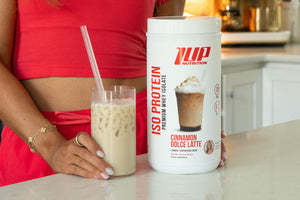You’ve heard it before -- a calorie is just a calorie.
And to some extent that is true.
If you consume more calories than you burn (regardless of what types of calories those are -- protein, carb, or fat), you will gain weight.
But, saying all calories are equal is a gross oversimplification of nutrition.
When you really start to dial down into the specifics, you realize that not all calories are the same.
Saying “a calorie is just a calorie” ignores the types of food you’re eating, their macronutrient composition, micronutrient content, and how hard your body has to work to digest that food.
That last point is what the focus of today’s article is -- how “hard” your body has to work to digest food, otherwise known as the thermic effect of food.
It can (and does) have an impact on your metabolism, and if you’re serious about losing weight, getting healthy, and finding a sustainable way to eat long term (thereby keeping weight off for good, then you want to pay attention to not only “calories”, but what types of foods you’re eating as well.
Let’s get started.
What is the Thermic Effect of Food?
As we just stated, the thermic effect of food (TEF) is how much energy the human body expends (“burns”) digesting, absorbing, and transporting the food you eat it into its subsequent components -- amino acids, sugars, and fatty acids.
The thermic effect of food also can also be found in the scientific literature under two other monikers:
- Dietary induced thermogenesis (DIT), or
- Specific dynamic action (SDA) or dietary-induced thermogenesis (DIT).
TEF is but one component of how many calories your body burns each day, otherwise known as your total daily energy expenditure (TDEE).
The other contributors to your TDEE are:
- Basal metabolic rate (BMR) -- amount of energy your body burns to keep you alive at rest -- breathing, circulation, organ function, etc. BMR also accounts for approximately 60–70% of daily energy expenditure in sedentary adults.[6]
- Non-exercise activity thermogenesis (NEAT) -- the amount of energy burned during non-structured physical activity (walking from one room to another, brushing your teeth, shaking up your protein shake, etc.)
- Exercise Activity Thermogenesis (EAT) -- the amount of energy expended (“calories burned”) during structured physical activity (i.e. exercise)
Note that not all four of these components have an equal impact on your total daily energy expenditure. And, it should also be mentioned that genetics do play a fairly prominent factor in a person’s total daily energy expenditure (by way of BMR, predominantly).[5]
Now, the bulk of your TDEE is comprised of your basal metabolic rate.
The other factors have some effect but are considerably lower.
The least impactful of these four factors is the thermic effect of food as it only constitutes ~10% of your total daily energy expenditure.
What this means is that if you’re banking on the thermic effect of food to be your one-way ticket to effortless weight loss, you’re boarding the wrong train.
Now, that doesn’t mean that your food choices don’t matter (they do), but thinking that you can create the ultimate thermogenic weight loss diet is a bit of a stretch.
Speaking of food choices, let’s next discuss how your choices at mealtime affect the number of calories your body burns each day.
How Food Choices Affect the Thermic Effect of Food
Different macronutrients require different amounts of energy to be processed by the body.
Dietary protein is very “expensive” for the body to process (meaning it takes more energy to breakdown, comparatively), while carbohydrates and fat are less energy-intensive.
More specifically, 20-35% of protein calories consumed are used to digest it, while a mere 5-15% of carbohydrate and fat calories consumed are used to process those macronutrients.[2,3]
While fat’s TEF is estimated at 5-15%, it typically falls to the lower end of the spectrum as fat is by far the easiest macronutrient for the body to process and store.
This is part of the reason, high-protein diets are recommended for those looking to enter transformation challenges and lose body fat.
Now, very few of us typically consume 100% of a single macronutrient at any one time (e.g. guzzling a cup of olive oil), which means each meal’s thermic effect of feeding is a weighted average of the foods included in a given meal.
Furthermore, how many calories your body burns digesting food is also affected by the size of your meal.
In other words, how much food you eat in a meal affects how much energy your body expends (i.e. smaller meals result in small increases in energy expenditure, while larger meals lead to larger increases in energy expenditure), but this expenditure caps out at a certain point.
Remember, the thermic effect of food only accounts for ~10% of all the calories your body burns in a day.
Further complicating the matter is that the thermic effect of food is also affected by the degree to which food is processed.
Research shows that highly processed foods are much more easily digested than their whole-food counterparts, which means your body burns fewer calories digesting a bag cheesy poofs than it does a bowl full of broccoli.
More specifically, a study by Barr et al. found that diet-induced thermogenesis was ~47% lower following a processed-food meal compared to a calorie-matched whole foods meal.[7]
It’s also worth noting that the mass consumption of hyper-processed, hyper-palatable foods is a key contributor to the present obesity epidemic.
Because of the high thermic effect of protein, in combination with the ease in which fats are digested, tweaking your food choices in favor of a more optimal macronutrient split may help reduce calorie intake and support weight loss.
Note, that these effects will really only reach significance if you presently are not consuming a high-protein diet.
For instance, if your current protein intake is only 10-15% of daily energy intake, increasing it to 30-40%, will have a significant impact on how many calories your body naturally burns each day.
This difference is likely large enough to support reductions in body fat while consuming the same amount of calories.
Remember, protein “costs” more energy to breakdown (2-3 times more) than either carbs or fat.
Now, there comes a point, where you can take things too far.
For instance, if you’re already consuming a high-protein diet (30-40% of daily calories or 1-1.2 grams per pound of bodyweight), bumping it up to 50-60% likely won’t have a meaningful impact on your energy expenditure.
Furthermore, consuming a diet that is >50% protein isn’t enjoyable, affordable, or sustainable for most individuals. Plus, you’ll also be moving your carbohydrates and fats to very low intakes, which isn’t sustainable (or enjoyable).
Diets should not be so overbearing and restrictive that they become burdensome.
If we’re being honest, the average person looking to lose fat, build muscle, and get fit can make drastic improvements to their performance and physique by making moderate adjustments to their diet.
To get results, you do not need to adopt any crazy fad diet that completely abolishes an entire group of foods.
By simply keeping these following tips in mind, you can improve your diet, boost energy naturally, and enhance your performance and quality of life.
- The majority of your diet (80-90%) should consist of whole (“clean”) foods (i.e. foods that are one ingredient -- chicken, apples, lean beef, rice, potatoes, broccoli, etc.).
- Consume enough protein each day (0.8-1.2 grams of protein per pound of bodyweight). This will support recovery and muscle growth, increase satiety and fullness, and help reduce hunger and cravings.
- Avoid the vast majority of hyper-processed, micronutrient-void food (the occasional treat is fine, but processed, pre-packaged food should NOT make up the majority of your diet).
- Avoid fast food and anything deep fried (i.e. battered, crispy, etc.)
- Remove calorie-containing liquids from the diet (fruit juices, soda, energy drinks, etc). These are sources of empty calories that do not improve performance, recovery, or health. They may also make you hungrier, too.
- Avoid extremes such as drastically undereating (or overeating) any single macronutrient (a la keto, carnivore, etc.). A balanced reduced-calorie diet is much more likely to be sustainable than an overly restrictive one.
Incorporating these changes into your daily diet will have a profound impact on your body composition, especially if you are training hard using a combination of resistance training and cardio.
Going from a low-protein diet to a high-protein diet will lead to a reduction in carb and fat intake, but you’ll also benefit from increased satiety, less hunger, and a higher metabolic rate, courtesy the thermic effect of food.
Is the thermic effect of food a “weight loss miracle” or “quick-fix” for fat loss?
Not at all.
But, when used in combination with a calorie-controlled diet, resistance training, cardio, and the right supplements, it can make a big difference.
References
- Trexler, E., Smith-Ryan, A., & Norton, L. (2014). Metabolic adaptation to weight loss: Implications for the athlete. Journal of the International Society of Sports Nutrition, 11, 7. https://doi.org/10.1186/1550-2783-11-7
- Halton, T., Hu, F. 2004. The effects of high protein diets on thermogenesis, satiety and weight loss: a critical review. Journal of the American College of Nutrition 23(5): 373-85
- Nair, K., Halliday, D., Garrow, J. 1982. Thermic response to isoenergetic protein, carbohydrate or fat meals in lean and obese subjects. Clinical Science 65: 307-312
- Barr SB, Wright JC. Postprandial energy expenditure in whole-food and processed-food meals: implications for daily energy expenditure. Food Nutr Res. 2010;54:10.3402/fnr.v54i0.5144. Published 2010 Jul 2. doi:10.3402/fnr.v54i0.5144
- Bouchard, C., Tremblay, A., Nadeau, A., Despres, J. P., Theriault, G., Boulay, M. R., Fournier, G. (1989). Genetic effect in resting and exercise metabolic rates. Metabolism: Clinical and Experimental, 38(4), 364–370.https://doi.org/10.1016/0026-0495(89)90126-1
- Ravussin E, Lillioja S, Anderson TE, Christin L, Bogardus C. Determinants of 24-hour energy expenditure in man. Methods and results using a respiratory chamber. J Clin Invest. 1986;78(6):1568–78. doi: 10.1172/JCI112749.
- Barr SB, Wright JC. Postprandial energy expenditure in whole-food and processed-food meals: implications for daily energy expenditure. Food Nutr Res. 2010;54:10.3402/fnr.v54i0.5144. Published 2010 Jul 2. doi:10.3402/fnr.v54i0.5144






